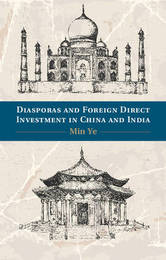
|
Diasporas and Foreign Direct Investment in China and India
Hardback
Main Details
| Title |
Diasporas and Foreign Direct Investment in China and India
|
| Authors and Contributors |
By (author) Min Ye
|
| Physical Properties |
| Format:Hardback | | Pages:260 | | Dimensions(mm): Height 236,Width 157 |
|
| Category/Genre | Development economics
Political economy |
|---|
| ISBN/Barcode |
9781107054196
|
| Classifications | Dewey:332.6730951 |
|---|
| Audience | | Professional & Vocational | |
|---|
| Illustrations |
25 Tables, unspecified; 3 Maps; 16 Line drawings, black and white
|
|
Publishing Details |
| Publisher |
Cambridge University Press
|
| Imprint |
Cambridge University Press
|
| Publication Date |
18 August 2014 |
| Publication Country |
United Kingdom
|
Description
This book offers a comparative and historical analysis of foreign direct investment (FDI) liberalization in China and India and explains how the return of these countries' diasporas affects such liberalization. It examines diasporic investment from Western FDIs and finds that diasporas, rather than Western nations, have fueled globalization in the two Asian giants. In China, diasporas contributed the lion's share of FDI inflows. In India, returned diasporas were bridges for, and initiators of, Western investment at home. Min Ye illustrates that diasporic entrepreneurs helped to build China into the world's manufacturing powerhouse and that Indian diasporas facilitated their homeland's success in software services development.
Author Biography
Min Ye is an Assistant Professor of International Relations and the director of the East Asian Studies Program at Boston University. She has served as a visiting scholar and professor in China, Japan, South Korea, Singapore, and India and has taught summer courses at Fudan University, Zhejiang University, and the Chinese University of Broadcasting and Mass Media. Her publications include The Making of Northeast Asia (with Kent Calder, 2010) and various articles published in such journals as the Journal of East Asian Studies, Modern China Studies, and China Public Affairs Quarterly. In China, Ye also serves as a consultant on globalization for private and state-run companies, including Baosteel and CHINT. She is on the advisory board for the construction of the Ocean Economic Development Zone in Zhejiang Province and the Baosteel High-Tech Zone in Guangdong Province.
Reviews'Economic studies of foreign direct investment have largely ignored the social context in which such investment takes place. In this powerful corrective, Min Ye traces the effects of diasporas not only on capital flows but on the wider policy context. She reinterprets the economic opening of the two developing giants - China and India - and their wider growth experience more generally.' Stephan Haggard, Krause Professor, Graduate School of International Relations and Pacific Studies, University of California, San Diego 'Foreign direct investment is often considered an exclusive purview of Western multinationals. Min Ye's book provides a fascinating comparison of the crucial role played by a different network - overseas co-ethnics - in promoting foreign direct investment in China and India. Her conclusion is that while diaspora-sourced FDI has been important in both countries, it has until recently been much less contested in China, shedding a new explanatory light on differences in these countries' respective paths to economic transformation. Ye's book is a novel and compelling contribution to the emergent comparative literature on the political economy of China.' Margaret M. Pearson, University of Maryland, College Park 'Foreign direct investment has been a main driving force behind the rapid development of Asia's two giant economies, China and India. The Western nations, the usual FDI sources in the developing world, were not the FDI providers, however. What has fuelled the globalization of the two economies? In this comparative and historical analysis, Min Ye reveals that it was the FDI patterns of the Chinese and Indian diasporas that have given rise to the differing performance of the two economies. All those who would like to uncover the secrets of these two Asian economies and their linkages with the rest of the world should read it; it is also a valuable guide for the future of the two increasingly important Asian giants.' Zheng Yongnian, National University of Singapore
|